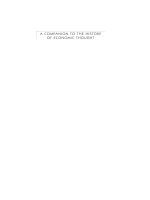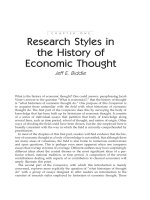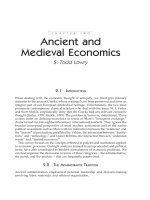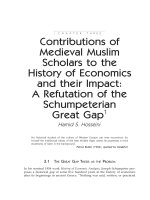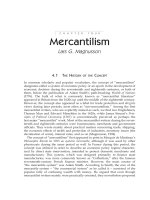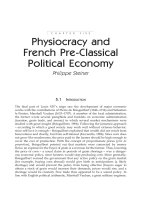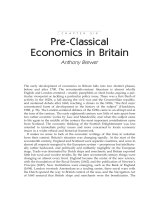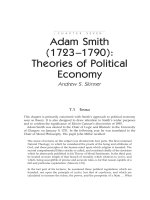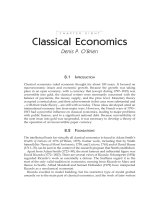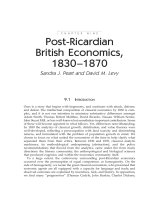A Companion to the History of Economic Thought - Chapter 9 docx
Bạn đang xem bản rút gọn của tài liệu. Xem và tải ngay bản đầy đủ của tài liệu tại đây (223.46 KB, 18 trang )
130 S. J. PEART AND D. M. LEVY
CHAPTER NINE
Post-Ricardian
British Economics,
1830–1870
Sandra J. Peart and David M. Levy
9.1 INTRODUCTION
Ours is a story that begins with hegemony, and continues with attack, defense,
and defeat. The intellectual composition of classical economics by 1830 is com-
plex, and it is not our intention to minimize substantive differences amongst
Adam Smith, Thomas Robert Malthus, David Ricardo, Nassau William Senior,
John Stuart Mill, or less well-known but nonetheless important contributors. Some
of these will become apparent in what follows. Yet, differences notwithstanding,
by 1830 the analytics of classical growth, distribution, and value theories were
well-developed, reflecting a preoccupation with land scarcity and diminishing
returns, and formulated with the problem of population growth in mind. We
choose to focus on what united the economists of the time to help clarify what
separated them from their critics. Between 1830 and 1870, classical analytic
machinery, its methodological underpinning (abstraction), and the policy
recommendations that flowed from the analytics, came under fire from many
directions: the literary community; the anthropological and biological sciences
that produced eugenics; and within the economics community itself.
To a large extent, the controversy surrounding post-Ricardian economics
occurred over the presumption of equal competence, or homogeneity. On the
side of homogeneity, we locate the great classical economists, who presumed that
economic agents are all equipped with a capacity for language and trade, and
observed outcomes are explained by incentives, luck, and history. In opposition,
we find many “progressives” (Thomas Carlyle, John Ruskin, Charles Dickens,
POST-RICARDIAN BRITISH ECONOMICS, 1830–1870 131
and Charles Kingsley), whose explanation for the observed heterogeneity of
custom and behavior was race. In our period, the notion of “race” is rather
ill defined, but the argument played out both in terms of the Irish and the former
slaves in Jamaica (Curtis, 1997). In addition, the “laboring classes” were sometimes
included in discussions of incompetence.
The economists’ explanation for observed heterogeneity was to appeal to the
incentives associated with different institutions. Classical economists such as
John Stuart Mill struggled with the problem of transition from one set of institu-
tions to another: How are new habits formed as institutions change? Economists
who have become accustomed to institution-free analysis may fail to appreciate
how much of classical economics is designed to deal precisely with this problem
of self-motivated human development in the context of institutional change.
Examples in what follows include the Irish land question, slavery, Mill’s higher
and lower pleasures, his analysis of economic growth, and Thornton’s famous
challenge to classical economics at the end of our period.
In the period that we study, economic analysis also supposed – as Mill put it in
his Essay on the Definitions of Political Economy; and on the Method of Investigation
Proper to It (1836; hereafter, Essay) – that it treats “man’s nature as modified by
the social state” (Mill, 1967a, p. 321). This supposition enabled classical econom-
ists such as Richard Whately and his student, Senior, to develop and improve
the science of exchange, “catallactics.” The catallactic tradition retained a key
role for nonmaterial concerns, what Smith had called “sympathy” as well as the
desire for approbation. As the period comes to a close, social sentiments disappear
from economics and material concerns become singularly important.
It is widely accepted that the boundary of economic science was narrowed
throughout the nineteenth century (Winch, 1972). This narrowing occurred with
the removal of sympathy and the rise in materialism from 1830 to 1870, as well
as the removal of institutional concerns from economic analysis, and the pre-
sumption of reversibility that underscores early neoclassical analysis by Fleeming
Jenkin. Jenkin’s argument was a critical blow against the classical supposition of
the importance of the status quo.
Homogeneity was not simply an analytic tool. The methodological position in
Mill’s Essay was that the economist must abstract from differences to focus on
the common. The method of abstraction was denounced throughout the period,
and early critiques of abstract economic man were made in the context of the
Irish question. The political economist and co-founder (with Francis Galton)
of the eugenics movement, W. R. Greg, attacked classical political economy for
its assumption that the Irishman is an “average human being,” rather than one
prone to “idleness,” “ignorance,” “jollity,” and “drink.”
9.2 HEGEMONY: GROWTH, DISTRIBUTION, AND VALUE
By 1830, classical analytic machinery consisted of well developed theories of
growth, distribution, and value – all formulated with the population mechanism
and land scarcity yielding diminishing returns in mind. Importantly for our
132 S. J. PEART AND D. M. LEVY
argument that follows, these theories abstract from race or any other features
such as religion or gender.
Classical growth theory presupposes a functional relationship between the
average real wage and population growth. Land scarcity (and the absence of
prudential population control) are said to create secular downward pressure
on the wage (and profit, or interest) rates. Presuming single-use land, rent is a
differential surplus. Increasing land scarcity reduces the growth rate of capital
accumulation and, consequently, the growth of labor demand. As what would
later be known as the marginal product of the composite labor and capital input
falls, this drives the returns to the variable factors, labor and capital, down. The
secular fall in the real wage is smaller than the fall in the marginal product, so the
wage share rises and profits fall, a result widely known today as the fundamental
theorem on distribution. The incidence of diminishing returns is thus shared by
capital (as lower profit rates) and labor (as lower wage rates or increased prud-
ential control). In a stationary state setting with zero net accumulation and zero
population growth, the subsistence wage pertains, along with a corresponding
subsistence rate of profit. In this – and other – details, our summary of classical
analytics follows the “New View” developed by Hollander, Levy (Levy, 1976;
Hollander, 2001), and others. For a restatement by Hollander, and for extensions
and criticisms, see Forget and Peart (2001).
In the simplest case when money and corn are produced with equal capital–
labor ratios, a labor theory of exchange value holds and any change in wages
leaves relative prices unaffected. If the labor embodied in gold remains constant
while diminishing returns pertains in corn production, then the (gold) value of
corn rises as a result of the reduction in labor’s productivity in the corn sector.
The (gold) value of the output of a unit of labor is invariable.
Using the gold measure of value, classical growth analysis also yields the inverse
wage–profit relationship: the profit rate is inversely related to the proportion of
output devoted to laborers as a whole. Thus, the inverse wage–profit relationship
holds both in value and physical terms. In these terms, growth again implies the
profit rate tends downward. Laborers receive a higher money wage rate. But
since the money value of the marginal output is constant, profits must also fall.
In classical analysis, “natural” – or cost – prices include both “ordinary” or aver-
age wages and profits; natural price is achieved through an allocative process
by which capital flows from low to high return industries until a uniform rate
of profit is achieved. In the event that factor proportions are fixed and uniform,
long-run equilibrium prices are proportionate to relative labor inputs. When fac-
tor proportions differ, prices are no longer proportionate to relative labor inputs
but, instead, reflect all costs. But the mechanism that ensures that cost prices will
emerge remains the same: profit rate differentials cause flows from low- to high-
profit sectors until equality is restored and a new set of relative prices emerges.
In large measure, the hegemony of classical analytics was due to the influence
of John Stuart Mill, whose refinements and restatements proved definitive through-
out the period. At the end of our period, William Stanley Jevons railed at the
“noxious influence” of Ricardo’s “equally able but wrong-headed admirer” (1871,
pp. 275, li). But Mill’s influence, as will become clear below, extended beyond
POST-RICARDIAN BRITISH ECONOMICS, 1830–1870 133
pure analytics to the defense of the classical presumption of homogeneity against
its racist critics, and to methodology and the hard problem of the “improvement
of mankind” (Robson, 1968).
Much of the coherence in the period was also the result of Nassau Senior’s
wide-ranging contributions, a fact that is appreciated by considering which
“Ricardians” Frank Knight selects as targets (Knight, 1935). Famously, Senior’s
abstinence theory of interest brought the real cost doctrine to savings, but his
contributions also tied together many loose threads of classical analysis. His
controversy with T. R. Malthus over the “tendency” for population to outrun sub-
sistence made it clear that a “tendency” became “forecast” only when the cost
of a family vanished, as it would under what Malthus referred to as “systems of
equality” – without government or property (Senior, 1998b [1829], pp. 87–9).
Senior’s contribution to the analysis of aggregate economic activity was equally
important to the classical system. Smith and Ricardo supposed a metallic money
provided by a competitive market (Smith, 1976, p. 435). But they failed to explain
how this works in a Britain without mines. Senior answered:
The mine worked by England is the general market of the world: the miners are
those who produce those commodities by the exportation of which the precious
metals are obtained. (Senior, 1998c [1830], p. 15)
Smith had supposed that the market for money cleared quickly (Smith, 1976,
pp. 435–6).
If we start with the supposition that the excess demand for money equals the
aggregate excess supply of goods (known today as Walras’s Law), then Smith’s
adjustment principle suffices to obtain Say’s Law – the aggregate excess supply
of goods is zero. Senior worked an example of how equilibrium in the classical
system is affected when a sudden contraction of the money supply resulted from
a bank panic:
A great portion . . . of what acted as the circulating medium of exchange throughout
the country becomes valueless; and the effects are precisely the same as if an equal
portion of the metallic currency of the country had been suddenly annihilated or
exported.
Then the classical price adjustment mechanism is called into play:
Prices fall, the importation of commodities is checked, and their exportation is
encouraged. The foreign exchanges become universally favourable, and the precious
metals flow in until the void, occasioned by the destruction of the paper currency,
has been filled. (Senior, 1998a [1828], p. 27)
9.3 HOW ECONOMICS BECAME THE “DISMAL SCIENCE”
Perhaps the hegemony of classical thought on population growth and the stationary
state is in part responsible for today’s misconceptions on the origins of the “dismal
134 S. J. PEART AND D. M. LEVY
science” phrase. Certainly, critics of the classical system would have us believe
so. And almost everyone believes that Carlyle called classical political economy
the “dismal science” as a response to T. R. Malthus’s prediction that population
would always grow faster than food, dooming mankind to unending poverty.
In fact, Carlyle’s target was not Malthus, but economists such as John Stuart
Mill, who argued that it was institutions, not race, that explained why some
nations were rich and others poor. It was the fact that economics assumed that
people were all the same, and were all entitled to liberty, that led Carlyle to label
economics the “dismal science.” It is too rarely appreciated (Persky, 1990; Levy,
2001; Levy and Peart, 2001–2) that economics became the “dismal science” in this
period because of a view of human nature that abstracted away from the poss-
ibility of racial difference. Classical economists were committed to the hardest
possible doctrine of analytic homogeneity. As a consequence, they opposed racial
slavery and paternalism, and they favored markets instead.
Here is the paragraph in which Carlyle first uses the “dismal science” phrase
as part of his attack on the anti-slavery stance of political economy:
Truly, my philanthropic friends, Exeter Hall Philanthropy is wonderful; and the
Social Science – not a “gay science,” but a rueful – which finds the secret of this
universe in “supply-and-demand,” and reduces the duty of human governors to
that of letting men alone, is also wonderful. Not a “gay science,” I should say, like
some we have heard of; no, a dreary, desolate, and indeed quite abject and distress-
ing one; what we might call, by way of eminence, the dismal science. These two,
Exeter Hall Philanthropy and the Dismal Science, led by any sacred cause of Black
Emancipation, or the like, to fall in love and make a wedding of it, – will give birth
to progenies and prodigies; dark extensive moon-calves, unnameable abortions,
wide-coiled monstrosities, such as the world has not seen hitherto! (Carlyle, 1849,
pp. 672–3)
Carlyle was the greatest enemy of the anti-slave coalition of political economists
and Christian evangelicals centered at Exeter Hall. His “Negro Question” re-
vived the pro-slavery movement in mid-century Britain (Denman, 1853, p. 12).
Mill’s response comes into print a month after Carlyle’s “Negro Question.” In
it, he condemned what he called “the vulgar error of imputing every difference
which he finds among human beings to an original difference of nature” (Mill,
1850, p. 29). He supposes that black people in Jamaica, being competent to make
economic decisions, respond to incentives just as any other people would.
The real meaning of the Carlyle–Mill debate became clear during the “Gov-
ernor Eyre Controversy” of 1865. The controversy was triggered by a seemingly
trivial event in the British colony of Jamaica. After minor skirmishes, the island’s
Governor, Edward James Eyre, took command, imposing martial law and calling
in the army. Over 400 Jamaicans were massacred, wire whips were used as
instruments of terror, and thousands were left homeless. In England, the Jamaica
Committee was formed to demand an investigation. Its members included every
classical political economist of note living at the time – J. S. Mill (its head), John
Bright, Henry Fawcett, J. E. Cairnes, Thorold Rodgers, and Herbert Spencer – as
well as Charles Darwin and T. H. Huxley. On the other side, the Eyre Defence
POST-RICARDIAN BRITISH ECONOMICS, 1830–1870 135
Fund was led by Carlyle, assisted by Ruskin. Additional literary figures on the
Eyre Defence included Dickens, Kingsley, and Alfred Lord Tennyson (Semmel,
1962). As the Jamaica Committee failed to obtain an indictment of Eyre and
Mill lost his seat in Parliament, the controversy was a great defeat for classical
political economy.
9.4 CATALLACTIC THEORY AND POLICY:
S
TARTING WITH TWO EXCHANGING
When Whately opened his Oxford lectures on political economy, he began with
Adam Smith’s teaching that exchange is a uniquely human activity. He also
explained in this context that political economy “takes no cognizance” of isolated
individuals, such as “Robinson Crusoe” (Whately, 1831, p. 7). Catallactics carries
with it the connotation of reciprocity. For Whately, as for Smith, dogs do not
exchange because they lack language and the concept of “fair.” Catallactics comes
with desires, including the desire for reciprocity.
Whately took the next step in the argument when he generalized from purely
voluntary exchanges to such involuntary exchanges as the provision of tax-
financed government services:
And it is worth remarking, that it is just so far forth as it is an exchange, – so far
forth as protection, whether adequate or not, is afforded in exchange for this
payment, – that the payment itself comes under the cognizance of this science. There
is nothing else that distinguishes taxation from avowed robbery. (Whately, 1832,
pp. 10–11)
The government service that he considered in detail was protection (Whately,
1833). For catallactic theorists, the question is not whether exchange is voluntary,
but whether it is mutually beneficial. Viewing government as an exchange has a
dramatic consequence: hierarchy vanishes and the consumer becomes sovereign.
Carlyle appreciated this consequence (Carlyle, 1987, p. 31), and he objected to the
analytic egalitarianism in catallactics; he realized that classical political economy
– the economics of exchange with reciprocity – provided a key weapon in the
war against slavery. If exchange with reciprocity is the mark of the human, then
slavery is a perversion of the social order.
9.4.1 Catallactic policy
Two acts of political exchange are central to the period: the 1833 Act of Eman-
cipation and the 1834 New Poor Law. As these are not customarily seen as
exchanges, we shall expand upon this view.
The abolition of slavery – a seven-year “apprenticeship” – was accompanied
by a £20 million “indemnity” to the slave-owners and a protective tariff on
West Indian sugar (Denman, 1853). The compensation principle of catallactics is
exchange. Here is Mill’s analysis in his 1848 Principles, in which he maintains that
136 S. J. PEART AND D. M. LEVY
emancipation, like all reforms, requires compensation: “Whether the object be
education; a more efficient and accessible administration of justice; reforms of
any kind which, like the Slave Emancipation, require compensation to individual
interests” (Mill, 1965, pp. 865–6).
Government as exchange requires the recognition of constraints. The problem
that Senior found with the “old” poor law was that it imposed only benefits on
recipients and, as a consequence, it created the incentive for indigence. As Senior
saw it, poor relief is desirable for those “poor” who are unable to earn their own
subsistence:
In one sense of that word, [“poor”] means merely the aggregate of the individuals
who, from infirmity, or accident, or misconduct, have lost their station as independ-
ent members of society, and are really unable to earn their own subsistence. These
persons form, in every well-ordered community, a small minority – a minority
which it is in the power, and therefore within the duty of society, to relieve; but, if
possible, to reduce, and certainly not to encourage. (Senior, 1998e [1841], p. 14)
But how can society separate the indigent, whom society stands willing to assist,
from those larger numbers who would simply like to be assisted? Senior proposed
a test, in the form of a trade:
. . . to connect the relief of the able-bodied with a condition which no man not in
real want would accept, or would submit to when that want had ceased. . . .
the able-bodied application, with his family, should enter a workhouse – should be
supported there by a diet ample indeed in quantity, but from which the stimulations
which habit had endeared to him were excluded – should be subjected to habits of
cleanliness and order, be separated from his former associates, and debarred from
his former amusements. (Senior, 1998e [1841], p. 30)
One proves one is destitute by trading, by accepting a wholesome life. In Senior’s
view, the New Poor Law provided the safety net of social insurance with the
quid pro quo of “indoor relief” in exchange for strict sumptuary controls. In
his review of Mill on intervention, Senior provided an additional example of
exchange-oriented government policy:
another exception is . . . [t]he observance of Sunday as a day of rest. . . . There is
probably no institution so beneficial to the labouring classes; and they are aware of
it. But without the assistance of law they would probably be unable to enforce it. In
the few businesses in which Sunday trading is allowed, every shop is open. Though it
would be beneficial to the whole body of druggists that every druggist’s shop should
be shut on Sunday, it is the immediate interest of every individual that his own shop
should be open. And the result is that none are closed. (Senior, 1998f [1848], p. 338)
9.5 ABSTRACT ECONOMIC MAN
Classical economists put forward a doctrine of abstract economic man, an analytic
egalitarianism that explains behavior in terms of incentives, luck, and history
POST-RICARDIAN BRITISH ECONOMICS, 1830–1870 137
(Smith, 1976, p. 28). Mill’s famous Essay provides a defense of the method of
abstraction (Blaug, 1980; Hausman, 1981). He maintains that the “assumed” hypo-
theses of political economy include a set of behavioral assumptions:
Political economy does not treat of the whole of man’s nature as modified by
the social state, nor of the whole conduct of man in society. It is concerned with
him solely as a being who desires to possess wealth, and who is capable of judging
of the comparative efficacy of means for obtaining that end. . . . It makes entire
abstraction of every human passion or motive; except those which may be regarded
as perpetually antagonizing principles to the desire of wealth, namely, aversion
to labour, and desire of the present enjoyment of costly indulgences. (Mill, 1967a,
p. 321)
The wealth-maximization axiom is selected because it is “the main and acknow-
ledged end” in “certain departments of human affairs” (p. 323). Perhaps more
than any economist of his time or since, Mill was a synthesizer. But, for reasons
of practicality in the face of multiple causation, he called for specialization in the
social sciences (Hollander and Peart, 1999).
In his 1848 Principles, Mill outlined the implication of such a method: it implies
a rejection of racial “explanations” of outcomes, which he condemned:
Is it not, then, a bitter satire on the mode in which opinions are formed on the most
important problems of human nature and life, to find public instructors of the
greatest pretensions, imputing the backwardness of Irish industry, and the want of
energy of the Irish people in improving their condition, to a peculiar indolence and
insouciance in the Celtic race? Of all vulgar modes of escaping from the considera-
tion of the effect of social and moral influences on the human mind, the most vulgar
is that of attributing the diversities of conduct and character to inherent natural
differences. (Mill, 1965, p. 319)
Mill’s abstraction from race and his focus instead on property rights were sharply
disputed in the decades that followed the publication of his Essay. W. R. Greg
objected specifically to the abstract accounts of human beings put forward by
classical economists on the grounds that they abstract from race:
“Make them peasant-proprietors,” says Mr. Mill. But Mr. Mill forgets that, till you
change the character of the Irish cottier, peasant-proprietorship would work no
miracles. He would fall behind the instalments of his purchase-money, and would
be called upon to surrender his farm. He would often neglect it in idleness, ignor-
ance, jollity and drink, get into debt, and have to sell his property to the newest
owner of a great estate. . . . Mr. Mill never deigns to consider that an Irishman is
an Irishman, and not an average human being – an idiomatic and idiosyncractic, not
an abstract, man. (Greg, 1869, p. 78)
James Hunt, the influential owner of the Anthropological Review, also repeatedly
attacked race-neutral accounts of human nature: “Mr. Mill, who will not admit
that the Australian, the Andaman islander, and the Hottentot labour under any
138 S. J. PEART AND D. M. LEVY
inherent incapacity for attaining the highest culture of ancient Greece or modern
Europe!” (Hunt, 1866, p. 122; see Levy, 2001).
The Irish question raised the issue of whether the conclusions of political
economy might be considered universally relevant or of limited applicability
(Bagehot, 1876). In the latter half of the century, attacks on the nature and scope
of economics focused on the relative roles of induction and deduction in eco-
nomics, and on the legitimacy of studying economic phenomena separately from
social phenomena (Peart, 2001, pp. 362–5). Mill’s proposal for widespread land
reform in Ireland as well as his 1870 review essay, Leslie on the Land Question,
argued, in line with the historicists such as T. E. C. Leslie (1873) and J. K. Ingram
(1878), that institutional differences in Ireland rendered the conclusions of polit-
ical economy invalid there.
In response to such concerns, Jevons’s recommendation went farther than Mill,
calling for even more specialization, now within the discipline (1871, xvi–xvii).
Jevons also insisted that mathematical methods be used in economic theory
(Schabas, 1990), commencing his 1866 Brief Account of a General Mathematical Theory
of Political Economy with a call to reduce the “main problem” of economics to
“mathematical form” (1866, p. 282). Perhaps most significantly, Ireland provides
a rare instance in which Jevons objected to Mill’s policy recommendation (land
tenure reform) (see Peart, 1990).
Thus, notwithstanding his own significant contributions to applied analysis
(Black, 1981; Peart, 2002), Jevons succeeded in taking a methodological step toward
narrowing economics, insulating economic analysis from institutional concerns
(Peart, 2001). For an additional example, consider his comparison of Cairnes’s
opposition to slavery with his own neutrality: “Though I greatly admire ‘Slave
Power’ as a piece of reasoning, I hardly go with you in your Northern Sympathies.
I am strictly neutral” (correspondence, April 23, 1864; Jevons, 1972–81, vol. 3, p. 53).
9.6 MATERIALISM AND SYMPATHY:
THE OCCUPATIONAL STRUCTURE OF WAGES
This narrowing of the discipline also entailed the removal from economics of non-
material concerns. It is a commonplace to read the utilitarian economists of our
period as simple materialists, concerned only with the aggregate wealth produced
by society. But recent scholars have distinguished utilitarians from Adam Smith,
for whom the desire for approbation is foundational and for whom approbation
is incommensurate with income. Smith’s treatment of the desire for approbation
carried by cultural norms extends to occupational choice. This begins one of the
great set topics in our period: the explanation of occupational wage differences.
As noted above, Smith holds that people are physically the same. If all people
are the same and labor markets are competitive, then wouldn’t wages equalize
across occupations? Indeed, Smith claims this is so when we take “wages” to
reflect the net advantages to employments, including nonpecuniary considerations
such as “the ease or hardship, the cleanliness or dirtiness, the honourableness
or dishonourableness of the employment” (Smith, 1976, p. 117). Smith does not
POST-RICARDIAN BRITISH ECONOMICS, 1830–1870 139
make the leap from the assertion that an occupation is useful to the assertion that
the occupation is approved, and this is where the materialism reading fails.
In our period, Smith’s results are accepted by a host of writers. Mountiford
Longfield argued that Smith’s conclusions follow from the assumption of local
mobility:
Increased profits of bricklayers, or the diminished gains of barristers, will not induce
any person to become a bricklayer who would otherwise become a barrister. Neither
will the diminished profits of bricklayers, to pursue the profession of the bar, and by
his competition reduce the gains of the profession to their proper level. This may be
the case, and yet the due proportion between the gains of those two professions, so
remote from each other, may be preserved by means of the intermediate professions.
These act as media of communication. (Longfield, 1834, pp. 84–5)
E. G. Wakefield called Smith’s analysis “one of the most admired and admirable
chapters,” “free from error,” and “complete” (Wakefield, in Smith, 1835, vol. 1,
p. 328). As the consulting economist behind the New Poor Law, Senior had
reflected carefully upon the impact of disapprobation on our choices. His 1836
Outline added texture to Smith’s account (Senior, 1998d [1836], p. 201).
In 1852, in the first edition of the work following his exchange with Carlyle on
slavery, Mill added to his analysis of this issue in the Principles. He remained
committed to the doctrine as “tolerably successful” (Mill, 1965, p. 380). But he
now alluded to the difference between theory and fact, and he sharpened his
statement of noncompeting groups:
But it is altogether a false view of the state of facts, to present this [inequality
of remuneration] as the relation which generally exists between agreeable and dis-
agreeable employments. The really exhausting and the really repulsive labours, instead
of being better paid than others, are almost invariably paid the worst of all, because
performed by those who have no choice. (Mill, 1965, p. 383)
The debate with Carlyle over the “Gospel of Labour” raised this point with a
vengeance.
Since the analytic device of sympathy falls out of economic analysis as the
transition to neoclassicism occurs, the question that arises is where does sympathy
go? It enters into debates in evolutionary biology. In 1864, A. R. Wallace claimed
that natural selection did not apply to humans because of sympathy, morality,
and the division of labor (1864, p. clxii). Wallace’s demonstration that natural
selection stops at the edge of sympathy is the beginning of the eugenics movement.
As Greg (1874) put it, sympathy blocked the “survival of the fittest,” and therefore
these sentiments ought to be suppressed.
9.7 INSTITUTIONAL REFORM AND HIGHER AND LOWER PLEASURES
When we neglect the problem of institutional reform, we lose the context
in which the analytic machinery of classical economics was developed. Mill’s
140 S. J. PEART AND D. M. LEVY
notorious statement of the difference between higher and lower pleasures in his
1861 Utilitarianism provides a case in point (Mill, 1969, p. 211). But the same idea
first appears in the 1848 Principles. The context is not of Mill’s making. Here is
Senior’s statement of the consequences of slavery on people’s habits:
[slavery] destroys all the nobler virtues, both moral and intellectual; that it leaves
the slave without energy, without truth, without honesty, without industry, without
providence; in short, without any of the qualities which fit men to be respected or
even esteemed. But mischievous as slavery is, it has many plausible advantages,
and freedom many apparent dangers. The subsistence of a slave is safe; he cannot
suffer from insufficient wages, or from want of employment; he has not to save
for sickness or old age; he has not to provide for his family; he cannot waste in
drunkenness the wages by which they were to be supported; his idleness or dishon-
esty cannot reduce them to misery; they suffer neither from his faults nor his follies.
(Senior, 1998e [1841], p. 2)
How do people make themselves into competent optimizers? Senior provides
no answer.
Mill tackles the problem in the same context. Emancipation is justified by the
increase in human happiness – the statement in response to Carlyle’s 1849
proposal for reenslavement (Mill, 1850) is considerably sharper on this regard –
not by any increase in material output. To civilize a man, one immerses him in
material desires:
To civilize a savage, he must be inspired with new wants and desires, even if not of
a very elevated kind, provided that their gratification can be a motive to steady and
regular bodily and mental exertion. If the negroes of Jamaica and Demerara, after
their emancipation, had contented themselves, as it was predicted they would do,
with the necessaries of life, and abandoned all labour beyond the little which in
a tropical climate, with a thin population and abundance of the richest land, is
sufficient to support existence, they would have sunk into a condition more barbarous,
though less unhappy, than their previous state of slavery. (Mill, 1965, p. 104)
While these material desires might not be approved in Mill’s society, they are
critical steps in the development of the capacity for self-reliance:
The motive which was most relied on for inducing them to work was their love of
fine clothes and personal ornaments. No one will stand up for this taste as worthy of
being cultivated, and in most societies its indulgence tends to impoverish rather
than to enrich; but in the state of mind of the negroes it might have been the only
incentive that could make them voluntarily undergo systematic labour, and so
acquire or maintain habits of voluntary industry which may be converted to more
valuable ends. (Mill, 1965, pp. 104–5)
If one can move to self-government entailing far-sighted concern for one’s
own interest, can one not take the additional step toward concern for others?
Materialism is a only a step toward this end (Mill, 1965, p. 105).
POST-RICARDIAN BRITISH ECONOMICS, 1830–1870 141
Whether Mill succeeds or fails – authorities are divided (Jevons, 1879;
Schumpeter, 1954; McPherson, 1982) – he points to a real difficulty in the trans-
ition between social states: habits that evolve for sensible reasons in one state
might be counterproductive in another.
9.8 CLASSICAL GROWTH THEORY
Mill integrates the problem of transformation from one set of institutions to
another into the classical theory of growth and distribution. As a Ricardian,
he holds that a tax on profits will slow growth and therefore be shared by the
workers in terms of wage reduction (Mill, 1965, p. 827). His distinction between
higher and lower wants enters into the analysis of growth in the first edition
of Principles, when he looks forward to a stationary state entailing the cultiva-
tion of the Art of Living, and easing the labor burden upon the poor (Mill, 1965,
p, 756). But just as “lower” wants help educate freed slaves to discipline them-
selves, so too the “trampling, crushing, elbowing, and treading on each other’s
heels, which form the existing type of social life” may play a vital role in the
development of a society’s norms. This is the lesson that Mill draws from the
American Civil War (Mill, 1965, p. 754). For Mill, higher aspirations encompass a
willingness to sacrifice for the happiness of others. This would hardly surprise
the moralist, Adam Smith, who begins the classical period of British economics
(Smith, 1976, p. 9).
9.9 THE POPULARIZERS: MARTINEAU ON SLAVERY
While this was a period of sustained challenge to classical economics, it was also
a period of great popularizers of political economy. It is, however, a disservice
to view Harriet Martineau as merely a re-teller of the stories of economics. We
consider her work for the same reason that Stigler (1949) chose to illustrate the
best of classical economics with Senior on the handloom weavers: practical prob-
lems tended to bring out their best work. For Martineau and her peers, the
question of great import was how the institution of slavery mattered. We point to
two nice pieces of analysis.
9.9.1 Harem economics
In her 1830s visit to America, Martineau found compelling evidence against
paternalistic accounts of slavery: fathers do not use their daughters sexually.
As a Malthusian, Martineau attended to the tradeoff between sex and material
income. She found in America an instance in which a man can have more of both
sex and material income by acquiring additional families, only one of which will
be white:
Every man who resides on his plantation may have his harem, and has every
inducement of custom, and of pecuniary gain,* to tempt him to the common practice.
142 S. J. PEART AND D. M. LEVY
*[The law declares that the children of slaves are to follow the fortunes of the
mother. Hence the practice of planters selling and bequeathing their own children.
– Martineau] (Martineau, 1837, vol. 2, p. 223)
Martineau is responding here to the slavery apologists’ claim that the morality
of slavery can be judged by the relative infrequency of prostitution in Southern
cities (Martineau, 1837, vol. 2, p. 325). So it can, she argues, but not in the way the
slavery apologists thought. The relative infrequency of prostitution in slave cities
provides evidence that slaves were used sexually in sufficient numbers to affect
the market demand for prostitution.
9.9.2 Market slavery
In her novel Demerara (1832), Martineau introduces a character, Alfred, who seems
to have studied political economy in Britain and who persuades his father to try
something Smithian:
“Task-work with wages,” said Alfred, pointing to his own gang; “eternal labor,
without wages,” pointing to the other. “It is not often that we have an example of
the two systems before our eyes at the same moment. I need not put it to you which
plan works the best.” (Martineau, 1832–4, vol. 2, pp. 70–1)
In America, the task work that she saw worried her. Is an efficient slavery
good (1837, vol. 2, pp. 157–8)?
9.10 TO WHAT ARE MULTIPLE EQUILIBRIA A CHALLENGE?
It is commonly held that the most famous single challenge to classical economics
in this period came in the form of an attack on classical wage theory launched
by William Thomas Thornton in 1869. Thornton begins with the now-famous
denunciation of the notion of supply and demand. He considers two methods of
auction: one that starts high and moves down; another that starts low and moves
up. Why, he asks, do we believe that the results from the two methods of auction
will always be the same (1869, pp. 47–8)? The question was particularly import-
ant in the light of the classical doctrine of the importance of the status quo: if the
only difference is where we begin the auction, and Thornton is correct that this
affects the resulting price, then the status quo matters.
Was Thornton’s challenge really a difficulty for classical economics? Two
important classical economists responded to his argument. John Stuart Mill’s
judgment was that Thornton had identified the possibility of multiple equilibria,
a nice addition to the standard doctrine:
[Mr. Thornton] has proved that the law of equalisation of supply and demand is not
the whole theory of the particular case. He has not proved that the law is not strictly
conformed to in that case. In order to show that the equalisation is not the law of
price, what he has really shown is that the law is, in this particular case, consistent
POST-RICARDIAN BRITISH ECONOMICS, 1830–1870 143
with two different prices, and is equally and completely fulfilled by either of them.
The demand and supply are equal at twenty shillings, and equal also at eighteen
shillings. The conclusion ought to be, not that the law is false, for Mr. Thornton does
not deny that in the case in question it is fulfilled; but only, that it is not the entire
law of the phenomenon. (Mill, 1967b, p. 637)
John Elliott Cairnes was more emphatic in endorsing Thornton’s “solution” to
the problem of the determination of price (1874, p. 110). Thus, two classical
economists of high regard considered the possibility of multiple equilibria with
considerable composure.
But it would not be long before Thornton’s case would be challenged, and the
importance of the status quo would be dismissed. Fleeming Jenkin begins his
1870 article with a methodological attack. Like Jevons, he traced the difficulties
of the recent debates to insufficient mathematical machinery (1887 [1870], vol. 2,
p. 76). After explaining how demand and supply curves can be used to describe
choice, Jenkin considers Thornton’s example:
In a Dutch auction buyers are as likely at first tentatively to let the seller offer
below the market price as to close with him above that price.
In an English auction, buyers are as likely to first to run up above the market price
as to stop bidding below it. . . .
The device by which Mr. Thornton has made it appear that in a Dutch and
English auction there might be two market prices, is to assume that the demand at
prices in the neighbourhood of the market price is constant at all prices; that the
same number, and no more, fish would be bought at 18s. as at 20s. In this case the
demand curve becomes horizontal near the market price; and as the supply curve is
also horizontal, the market price is indeterminate. This case is not peculiar to any
form of bargain, but represents an unusual state of mind. (Jenkin, 1887 [1870], vol. 2,
pp. 84–5)
Jenkin’s conclusion – that Thornton assumes “an unusual state of mind” – is
the basis of Stigler’s (1954) judgment that Thornton depends upon a “bizarre”
demand curve.
Jenkin has transformed a difficult probabilistic problem – What are the other
bidders going to do? – into a demand curve in which probabilistic elements have
vanished. He does not allow for the possibility that bidders form different beliefs
in the different institutional setting, since, if this happens, there is no reason to
predict that bidders will behave the same way in the two types of auction. For
Jenkin’s argument, and the neoclassical arguments to come, Thornton’s counter-
example had to be dispatched.
Neoclassical economics thus begins with the claim, contra Thornton and
the classical consensus, that the status quo does not matter. The question of
the English and Dutch auction has since become a staple of the experimental
economics literature, and the answer is in. The classics were right: the method
of auction matters. This difference can be routinely replicated (V. Smith, 1982,
pp. 943–4). Thus, in the context of the attack on classical theory, we find an
additional, and misguided, case of denial of the significance of institutions.
144 S. J. PEART AND D. M. LEVY
9.11 CONCLUSION: TRAPPED IN THE STATUS QUO
We have applied the classical insight that the status quo is important to our
reading of the classics. From our status quo, in which racial explanations are
anathema, we see nothing unusual in the classical doctrine that racial explanations
are the height of “vulgarity,” as John Stuart Mill put it. Philosophers who radically
move the status quo tend to seem commonplace when viewed from the status quo
of their creation. But this supposition of unoriginality cannot survive immersion
in the context of mid-nineteenth-century controversy: what one does not read
can matter for what one does read. Thus, we hold that all texts are connected,
and the history of economics ought to be a general equilibrium procedure.
Opponents of classical economics held that some races (blacks and the Irish)
were child-like and thus ill equipped to make decisions on their own behalf.
Such races required the benevolent master to guide their actions. The linchpin of
the classical economists’ opposition to both slavery and paternalism was their
presumption of human competence which disallows masters, whether they own,
rule, or look after their inferiors in a kindly fashion. For, supposing that the social
world is composed of equally competent optimizers, there is no group that needs
looking after and no group that can do the looking after. In post-Ricardian eco-
nomics, there are no victims with whom to empathize: trades are voluntary and
mutually beneficial.
This world without victims is surely what gives classical economics its reputation
for hard-heartedness. By contrast, the great charm of paternalistic accounts is the
compassion that they allow for the victims of voluntary transactions. And the
temptation is to construct a class of victimizers (“parasites” is the term of choice
in the literature of the time) who optimize all too well for their own interest
(Levy and Peart, 2001–2). In the period that follows, social scientists succumbed
to this temptation: eugenicists argued that society had the right to curtail breeding
by such parasites, the “unfit” (Peart and Levy, 2003).
Note
We thank the editors of the volume for comments that led to significant improvements.
Bibliography
Bagehot, W. 1876: The postulates of political economy. Fortnightly Review, 21 o.s. (15 n.s.)
(1), 215–42.
Black, R. D. C. 1981: William Stanley Jevons 1835–82. In D. P. O’Brien and J. R. Presley
(eds.), Pioneers of Modern Economics. London: Macmillan, 1–35.
Blaug, M. 1980: The Methodology of Economics, or How Economists Explain. Cambridge, UK:
Cambridge University Press.
Cairnes, J. E. 1874: Some Leading Principles of Political Economy Newly Expounded. London:
Macmillan.
[Carlyle, T.] 1849: Occasional discourse on the Negro Question. Fraser’s Magazine for Town
and Country, 40, 670–9.
POST-RICARDIAN BRITISH ECONOMICS, 1830–1870 145
Carlyle, T. 1987: Sartor Resartus, ed. K. McSweeney and P. Sabor. Oxford: Oxford University
Press.
Curtis, L. P. Jr. 1997: Apes and Angels: The Irishman in Victorian Caricature, rev. edn.
Washington, DC: Smithsonian Institution Press.
Denman, Lord 1853: Uncle Tom’s Cabin, Bleak House, Slavery and Slave Trade, 2nd edn.
London: Longman, Brown, Green and Longmans.
Forget, E. L. and Peart, S. J. 2001: Reflections on the Classical Canon in Economics: Essays in
Honor of Samuel Hollander. London: Routledge.
[Greg, W. R.] 1869: Realities of Irish life. Quarterly Review, 126, 61–80.
Greg, W. R. 1874: Enigmas of Life. Boston: J. R. Osgood.
Hausman, D. M. 1981: J. S. Mill’s philosophy of economics. Philosophy of Science, 48(3),
363–85.
Hollander, S. 2001: Classical economics: a reification wrapped in an anachronism? In
Forget and Peart, op. cit., 7–26.
—— and Peart, S. J. 1999: John Stuart Mill’s method in principle and in practice. Journal of
the History of Economic Thought, 21(4), 369–97.
Hunt, J. 1866: Race in legislation and political economy. The Anthropological Review, 4, 113–
35.
Ingram, J. K. 1878: Address of the President of Section F of the British Association. Journal
of the Royal Statistical Society, 41, 602–29.
Jenkin, F. 1887 [1870]: Papers, Literary, Scientific, &c. London: Longmans, Green and Co.
Jevons, W. S. 1866: Brief account of a general mathematical theory of political economy.
Journal of the Royal Statistical Society, xxix, 282–7.
—— 1879: John Stuart Mill’s philosophy tested. iv. Utilitarianism. Contemporary Review, 36,
521–38.
—— 1909 [1871]: Theory of Political Economy, 4th edn., ed. H. S. Jevons. London: Macmillan.
—— 1972–81. Papers and Correspondence of William Stanley Jevons, ed. R. D. C. Black.
London: Macmillan.
Knight, F. H. 1935: The Ricardian theory of production and distribution. Canadian Journal
of Economics and Political Science, 1, 3–25.
Leslie, T. E. C. 1873: Economic science and statistics. Athenaeum, September 27. Reprinted
in Essays in Political and Moral Philosophy. Dublin: Hodges, Foster, and Figgis, 1879.
Levy, D. M. 1976: Ricardo and the Iron Law: a correction of the record. History of Political
Economy, 8(2), 235–51.
—— 2001: How the Dismal Science Got Its Name: Classical Economics and the Ur-Text of Racial
Politics. Ann Arbor, MI: University of Michigan Press.
—— and Peart, S. J. 2001–2: Secret history of the dismal science. Accessed at http://
www.econlib.org
Longfield, M. 1834: Lectures on Political Economy. In R. D. C. Black (ed.), The Economic
Writings of Mountifort Longfield. New York: Augustus M. Kelley, 1971.
Martineau, H. 1832–4: Illustrations of Political Economy. London: Charles Fox.
—— 1837: Society in America. London: Saunders and Otley.
McPherson, M. S. 1982: Mill’s moral theory and the problem of preference change. Ethics,
92, 252–73.
[Mill, J. S.] 1850: The Negro Question. Fraser’s Magazine for Town and Country, 41, 25–31.
Mill, J. S. 1965 [1848]: The Principles of Political Economy with Some of Their Applications to
Social Philosophy. Robson, Collected Works, op. cit., vol. 2.
—— 1967a [1836]: On the definition of political economy; and on the method of investiga-
tion proper to it. In Robson, Collected Works, op. cit., vol. 4, Essays on Economics and
Society, 1: 1824–1845.
146 S. J. PEART AND D. M. LEVY
—— 1967b [1869]: Thornton on labour and its claims. In Robson, Collected Works, op. cit.,
vol. 5, Essays on Economics and Society, 2: 1850–1879, pp. 633–68.
—— 1967c [1870]: Leslie on the land question. In Robson, Collected Works, op. cit., vol. 5,
Essays on Economics and Society, 2: 1850–1879, pp. 671–85.
—— 1969 [1861]: Utilitarianism. In Robson, Collected Works, op. cit., vol. 10, Essays on
Ethics, Religion and Society, pp. 203–59.
Peart, S. J. 1990: Jevons’s applications of utilitarian theory to economic policy. Utilitas, 2(2),
281–306.
—— 2001: Theory, application and the canon: the case of Mill and Jevons. In Forget and
Peart, op. cit., 356–77.
—— 2002: “Facts carefully marshalled” in the empirical studies of William Stanley
Jevons. In J. L. Klein and M. S. Morgan (eds.), The Age of Economic Measurement. Annual
Supplement to History of Political Economy, 33. Durham, NC: Duke University Press,
252–76.
—— and Levy, D. M. 2003: “Not an average human being”: how economics succumbed to
racial accounts of economic man. In D. Colander, R. Prasch, and F. Sheth (eds.), Race,
Liberalism and Economics. Ann Arbor, MI: University of Michigan Press, forthcoming.
Persky, J. 1990: Retrospectives: a dismal romantic. The Journal of Economic Perspectives, 4,
165–72.
Robson, J. M. (ed.) 1963– : Collected Works of John Stuart Mill. Toronto: University of
Toronto Press.
—— 1968: The Improvement of Mankind: The Social and Political Thought of John Stuart Mill.
Toronto: University of Toronto Press.
Rutherford, D. (ed.) 1998: Collected Works of Nassau William Senior, 3 vols. Bristol, UK:
Theommes Press.
Schabas, M. 1990: A World Ruled by Number: William Stanley Jevons and the Rise of
Mathematical Economics. Princeton, NJ: Princeton University Press.
Schumpeter, J. A. 1954: History of Economic Analysis. New York: Oxford University Press.
Semmel, B. 1962: The Governor Eyre Controversy. London: MacGibbon & Kee.
Senior, N. W. 1998a [1828]: Three lectures on the transmission of precious metals.
In Rutherford, op. cit., vol. 2, Money.
Senior, N. W. 1998b [1829]: Two lectures on population. In Rutherford, op. cit., vol. 3,
Population and the Poor Laws.
Senior, N. W. 1998c [1830]: Three lectures on the cost of obtaining money. In Rutherford,
op. cit., vol. 2, Money.
Senior, N. W. 1998d [1836]: An outline of the science of political economy. In Rutherford,
op. cit., vol. 1, Political Economy.
Senior, N. W. 1998e [1841]: Poor Law reform. In Rutherford, op. cit., vol. 3, Population and
the Poor Laws.
Senior, N. W. 1998f [1848]: J. S. Mill on political economy. In Rutherford, op. cit., vol. 1,
Political Economy.
Smith, A. 1835 [1776]: An Inquiry into the Nature and Cause of the Wealth of Nations, ed.
E. G. Wakefield. London: Charles Knight and Co.
—— 1976 [1776]: An Inquiry into the Nature and Causes of the Wealth of Nations, ed. W. B.
Todd. Oxford: The Clarendon Press.
Smith, V. 1982: Microeconomic systems as an experimental science. The American Economic
Review, 75, 923–95.
Stigler, G. J. 1949: Five Lectures on Economic Problems. London: Longmans, Green.
—— 1954: The early history of empirical studies of consumer behavior. The Journal of
Political Economy, 62, 95–113.
POST-RICARDIAN BRITISH ECONOMICS, 1830–1870 147
Thornton, W. T. 1869: On Labour, Its Wrongful Claims and Rightful Dues, Its Actual Present
and Possible Future. London: Macmillan.
Wallace, A. R. 1864: The origin of human races and the antiquity of man deduced from the
theory of “natural selection.” Journal of the Anthropology Society, 2, clviii–clxx.
Whately, R. 1831: Introductory Lectures on Political Economy. London: B. Fellowes.
—— 1832: Introductory Lectures on Political Economy, 2nd edn. London: B. Fellowes.
—— 1833: Easy Lessons on Money Matters; For the Use of Young People. London: John
W. Parker.
Winch, D. 1972: Marginalism and the boundaries of economic science. History of Political
Economy, 4(2), 325–43.
